WaterUps makes Urban greening and rain gardens easier for councils
Urban Greening is a major focus for councils as they seek to provide more environmentally friendly cities to combat climate change, cool public spaces, manage smog and flash flooding events, and enable more liveable cities.
Healthy thriving plants are key to making this happen. Urban greenspaces help reduce urban heat maps. They can, however, be difficult and very costly to maintain due to the absence of readily accessible sources of water and the requirement for council workers to sustain an ongoing watering schedule – which often stretches council staffing resources.
Poor quality and neglected garden beds are also an invitation to litterers, whereas lush, full gardens are a deterrent, helping to create a more aesthetic environment.
How WaterUps is helping Councils with Urban Greening
WaterUps is working with local councils and our partners to provide a range of solutions to help with these endeavours:
- Green Streetscapes & Road Verges
- Green Public Spaces
- Bollard Tree Tubs
- In-ground Tree planters
- Stormwater Management with rain water capture
- Rain Gardens
- Rooftop Gardens
- Community Gardens & Communal Housing
Further details and examples can be found below.

Green Streetscapes & Road Verges
WaterUps wicking beds are used in a range of street planter boxes and large tree tubs to support vigorous plant, shrub and tree growth, where in the past it has been difficult to have any greenery due to a lack of available water.
Along busy streets in Sydney like Military Road we have worked with North Sydney Council to provide planter boxes that, due to our unique water wicking system, only need 20% of the water used in above ground beds. This means they can be accommodated by a council’s watering schedule.
Previously, such planter boxes and tubs would rely on rainwater, occasional or rare watering from council trucks or property managers, or use succulent plants or plants with low water requirements like rosemary, to provide some degree of urban greening.
WaterUps wicking beds support a vast array of plant types and are far more water efficient than above ground water systems like sprinklers or hoses.
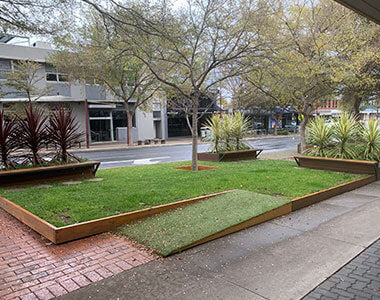
Green Public Spaces
WaterUps is helping save water and reduce the cost of maintaining urban greenspaces in public squares, pop-up venues playground areas, and green screen restaurant barriers.
In Blacktown and Coogee NSW WaterUps was incorporated into Plantabox® pop-up parks enabling the Blacktown and Waverley Councils to place attractive mature greenery on built areas as community spaces. This initiative fosters a greater sense of community, bringing people into CBDs, which in turn helps local businesses. The WaterUps wicking system reduced maintenance and allowed the plants to thrive in the hot environment of such spaces. Horsham, in Victoria, is also using WaterUps for this purpose in a Plantabox pop-up park.
WaterUps is used in furniture by PlantaBox, Draffin®, Street Furniture Australia® and Satu Bumi® .
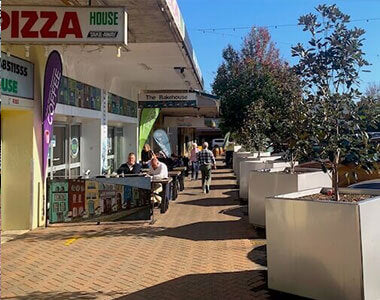
Bollard Tree Tubs
As well as our street furniture partners, WaterUps has created its own range of large stainless steel and aluminium planters with inbuilt wicking systems to create dual purpose urban greening.
Forbes Shire Council wanted to install large tree planters as bollard protection while giving the streetscape of the city centre more character. The council was after a low maintenance solution that would keep trees healthy over the hot summers of Western NSW. Little Gem Magnolias was the chosen species of trees.
Our Street Tree Tubs are manufactured in Sydney and incorporate WaterUps wicking cells and joiners and a central vertical overflow pipe in the base.

In-Ground Tree Sub-Irrigation
WaterUps is trialling in-ground WaterUps Sub-Irrigation Channels (SICs) with two Sydney councils to assist with the growth and survivability of new tree plantings.
Councils recommended that trees are watered at least weekly for the first year to optimise survival rates.
The WaterUps trials are expected to show increased survival rate and stronger growth with less frequent watering by using SICs and taking advantage of available rainwater capture.
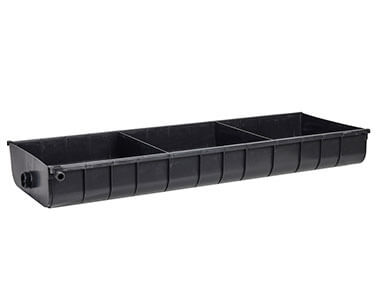
Stormwater Management
The WaterUps Sub-Irrigation Channel (SIC) encases the wicking cells in an enclosed container that can be incorporated easily into traditional conveyance stormwater management systems to provide water capture for longer term plant watering.
A 1.2m SIC section can hold 51 litres of water. We are partnering with storm water management companies to include WaterUps water capture and storage into their systems.
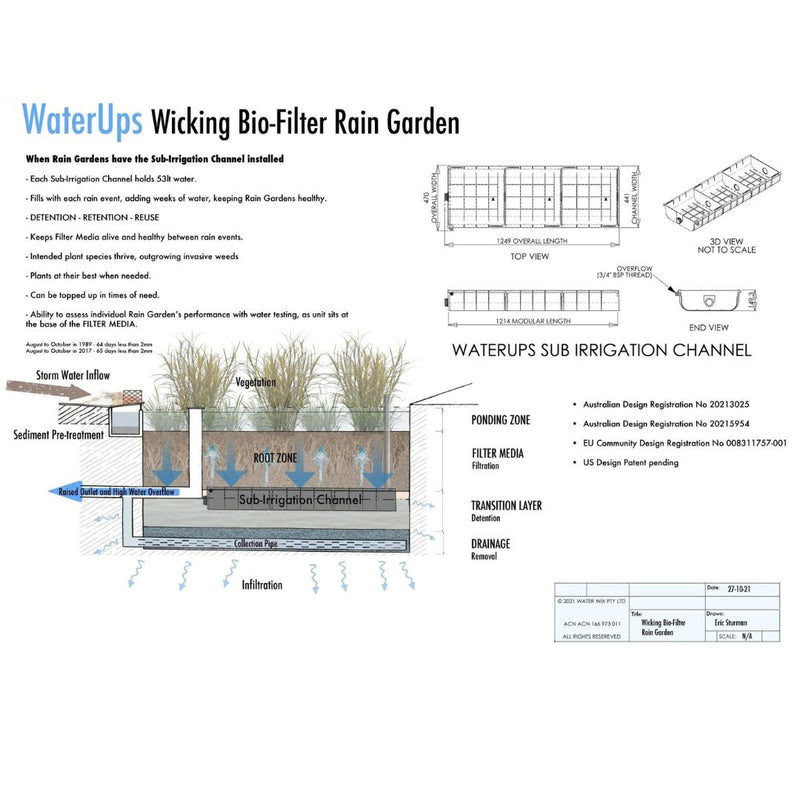
Rain Gardens
Rain gardens or bio-retention systems protect our waterways from being polluted with excess nutrients, rubbish and toxins from stormwater runoff. They tend to work less effectively after extended dry periods. WaterUps can be used to extend the effective life of rain gardens by retaining more rainwater and stormwater over a longer period, so the plants have a better, regular supply of water.
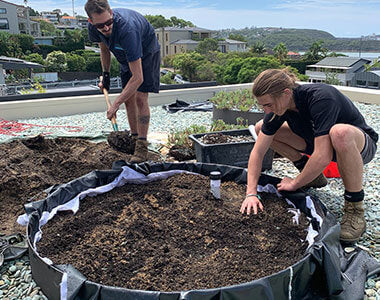
Rooftop Gardens
While largely a domain of property developers, councils are influencing the uptake of rooftop gardens to create more climate friendly cities as well as unique, vibrant, and green city skylines.
Brisbane City Council has recently paved the way for more rooftop gardens in preparation for the Brisbane Olympics in 2032, with rooftop gardens not being included in designated building height limits.
You can read more about our suitabilty for rooftop gardens here.

Community Gardens
WaterUps is used by several community gardens, many in part funded by local councils, to provide edible gardens for local communities. These gardens reap the benefits that come with the WaterUps, particularly when used in raised garden beds, saving time, money and water.
Since 2020, WaterUps has also been part of The Royal Botanic Garden Sydney Community Greening initiative, which aims to help community housing tenants to grow their own food. WaterUps planters have been installed at community housing blocks in South Coogee and Balmain in Sydney and in many low-income community situations across NSW. Under the Sowing Seeds of Hope program WaterUps have also been installed in community gardens as part of the botanical gardens’ bush fire recovery initiative in southern NSW.
A Growing Need for Urban Greening
With 70% of the world likely to be urbanised by 2050 and urban areas already responsible for over 75% of global carbon emissions, the more we can do in our towns and cities to mitigate the impacts of climate change and our human footprint the better.
WaterUps is keen to work with councils to implement urban greening projects at the scale we need to, to help improve the outlook for our communities, humanity and our planet.
WaterUps is an Australian innovation that uses 100% recycled plastic to dramatically save water usage and time while creating stronger, healthier plants.





